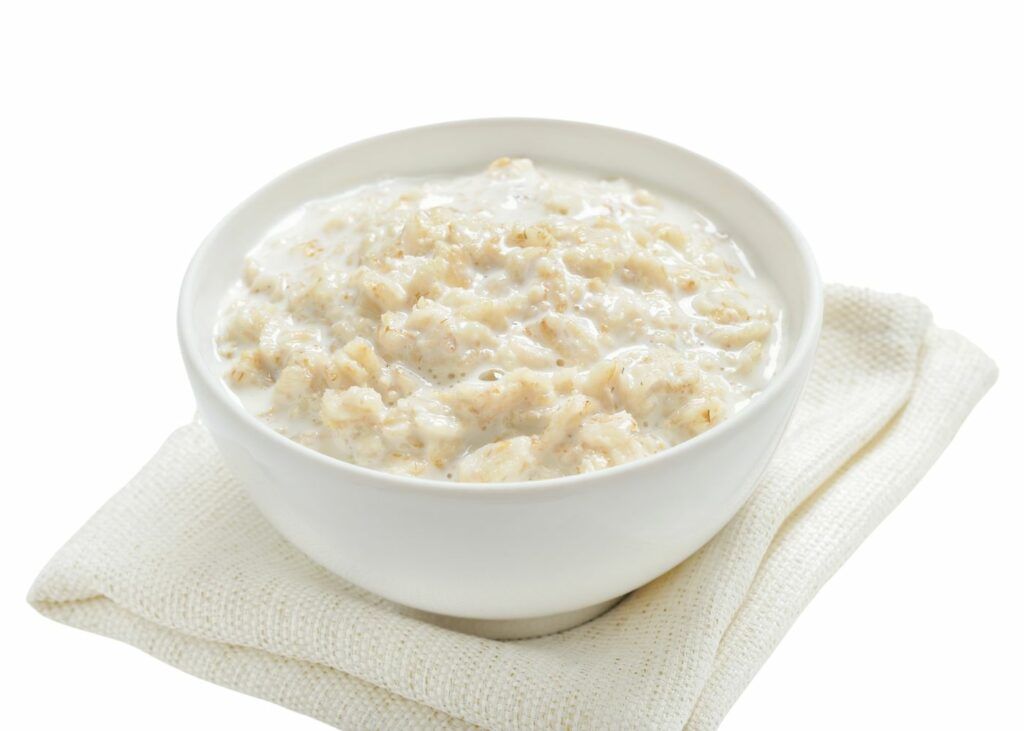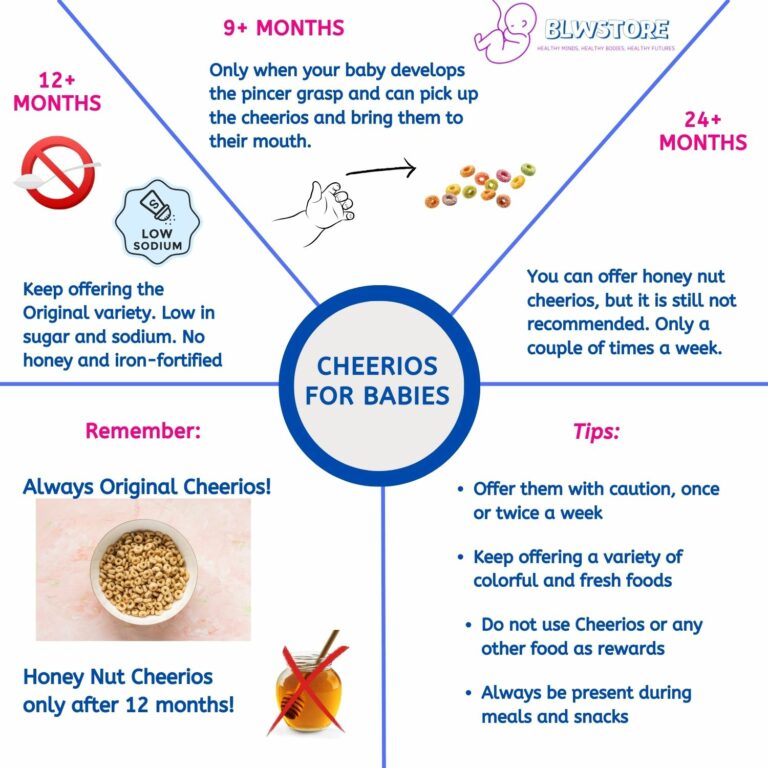
Introducing cereal to your baby during Baby-Led Weaning (BLW) can be an exciting and crucial milestone in their journey toward solid foods.
It is a time when you witness your little one exploring new tastes and textures and strengthening their fine motor skills as they learn to eat independently.
But when should you introduce cereal into the mix, and how can it be done safely while making it enjoyable for your little one?
This blog post will guide you through everything you need to know about incorporating cereals during BLW—from the best types of cereals for babies to some scrumptious cereal-based recipes that even fussy eaters will love!
Let’s get after it!
*Related read: Best Carbs for Babies
Key Takeaways
Introduce cereal when your baby is ready for solid foods, usually around 6 months.
Breast milk or formula should remain the primary source of calories and nutrients until the baby is 12 months old.
Opt for nutritionally dense cereals like whole grain, oatmeal, or quinoa over baby cereals.
Don’t overcomplicate things; offer cereal as part of a balanced and nutritionally dense diet.
When Can Babies Eat Cereal?
Babies can begin having cereal when they are ready for solid foods, usually around the 6-month mark.
Remember that every baby is different and may develop at a different pace.
Breast milk or formula will continue to be the main source of calories and nutrients until the baby is 12 months old.
While we don’t recommend starting your baby-led weaning (BLW) journey with cereal as the first food, it can still be included in your baby’s diet for convenience.
Start cereal around 6 months: Introduce cereal when your baby is ready for solid foods, remembering that each baby develops at their own pace.
Breast milk or formula remains essential: These should remain the primary sources of calories and nutrients until the baby is 12 months old.
Cereal is not a top choice for BLW: While convenient, other nutritionally dense options should be prioritized in the first 100 foods for BLW.
Watch for developmental signs: Ensure your baby can hold their head up steadily and sit upright with support before introducing solids.
Observe readiness cues: Look for signs like putting hands in the mouth, indicating your baby is ready for new foods, especially when following the BLW approach.
Is Cereal Good For Babies?
Cereal may not be the healthiest food option for babies and adults, but it can be a convenient choice for a balanced diet.
With that in mind, selecting the right type of cereal and introducing it at the appropriate age for your baby is essential.
When considering cereal for babies, look for options that are:
Iron-fortified: Babies have a high need for iron, especially after six months of age, when their iron stores from birth begin to deplete. Iron-fortified cereals, such as single-grain baby cereals like rice, oatmeal, or barley, can help provide this essential nutrient.
Low in sugar and salt: Choose cereals with little or no added sugars and salt, as babies don’t need these additives, and consuming too much can harm their health.
It’s important to continue breastfeeding or formula feeding alongside BLW to ensure your baby gets all the necessary nutrients.
Choose iron-fortified, low-sugar and salt, and easily digestible cereals for your baby to introduce around six months of age as part of a balanced diet.
What Type Of Cereal Should You Buy For Your Baby?
If we were to choose one type of cereal, we would always go for oatmeal, thanks to its versatility and nutritional benefits.
We did so with our son Pablo; now, it is his favorite breakfast.
Oatmeal’s high fiber and protein content make it a filling and satisfying option.
Plus, the beta-glucans in oats can help lower cholesterol levels and improve heart health.
Oats are also a prebiotic food that can help to promote a healthy microbiome.
If you’re interested, check out Pablo’s favorite oats recipe to see how to incorporate this nutritious cereal into your diet.
7 Key Cereal Info Tips for Babies
Opt for iron-fortified cereals: Babies require more iron after the 6-month mark.
Rice cereal: Popular due to low allergenic potential and easy digestibility.
Non-rice and multi-grain cereals: Great alternatives with less arsenic than rice cereal.
Read labels carefully: Choose whole grains and minimal added sugars for better nutrition.
Start with single-grain cereals: Rice or oatmeal are good first foods for introducing solids.
Introduce multi-grain blends later: As babies grow, include options like quinoa or amaranth.
Consider organic or homemade cereals: Ensures nutritious options without unnecessary additives. Keep reading to see how to make homemade cereals.
Types of Cereal Table
| Type of Cereal | Pros | Cons |
|---|---|---|
| Rice |
|
|
| Corn |
|
|
| Quinoa |
|
|
| Whole Wheat |
|
|
| Spelt |
|
|
| Barley |
|
|
| Oatmeal |
|
|
How To Prepare And Offer Cereal To Your Baby
Preparing cereal for your baby can be quick and easy, regardless of whether you choose spoon-feeding or BLW.
Read on to learn the best ways to prepare and offer cereal to ensure a safe and enjoyable mealtime experience with your little one.

How To Prepare Cereal For A 6-month-old
Choose your cereal of choice (rolled oats our favorite)
Mix one tablespoon of the cereal with four to five tablespoons of breast milk or formula.
Stir well until it forms a smooth consistency that’s not too thick or too runny and blend it.
Make sure the mix is lukewarm before offering it to your baby.
You may add some cinnamon to add some flavor
Start by offering small amounts, around one to two teaspoons at a time.
Use a small spoon and offer it in between milk feeds when your baby is alert and hungry.
How To Prepare Cereal For A 10-month-old And Up
At 10 months old, your baby is ready for thicker and more textured cereal. Here’s how to prepare cereal for your little one:
Mix 3 to 4 tablespoons of the cereal of choice with water or breast milk/formula until the mixture is thick and smooth.
Introduce new flavors by mixing in pureed fruits or vegetables.
Offer small spoonfuls of the cereal and let your baby practice feeding themselves.
Allow your baby to explore different textures by gradually thickening the cereal.
As your baby becomes more comfortable with thicker textures, you can add chunkier pieces of fruits or vegetables to their cereal.
Cereal Recipes For Baby-Led Weaning
Here are some of our favorite easy-to-make and nutritious cereal recipes that are perfect for parents who practice baby-led weaning: oatmeal puree, rice cereal veggie bites, Baby-approved cereal bars and cereal-coated fruit slices.
Oatmeal Puree (6+ Months)
|
Oatmeal Puree |
|---|
| Ingredients |
| Old-fashioned rolled oats |
| Water or breast milk/formula |
| Mashed ripe banana or apple |
| Cinnamon or nutmeg (optional) |
| Instructions |
| 1. In a small saucepan, combine the oats and water/breast milk/formula. |
| 2. Bring to a boil over medium heat, stirring frequently. Reduce the heat to low and simmer for 5-7 minutes or until the oats are soft and fully cooked. |
| 3. Remove from heat and let cool for a few minutes. |
| 4. Stir in mashed banana and cinnamon or nutmeg (optional). |
| 5. If necessary, use a blender or food processor to achieve a smoother consistency. |
| 6. Serve lukewarm or at room temperature. |

Rice Cereal Veggie Bites (7+ Months)
| Ingredients | Instructions |
|---|---|
| – 1 cup cooked and mashed sweet potato, carrots, or peas | 1. Preheat your oven to 350°F (180°C). |
| – 1 cup fortified infant rice cereal | 2. In a medium-sized mixing bowl, combine the mashed vegetables and rice cereal. Mix until a thick paste forms. |
| – 1/4 cup grated zucchini (optional) | 3. Optional: Add the grated zucchini to the mixture for added texture and nutrition. Mix well. |
| – 1/4 cup grated fresh cheese (optional) | 4. Optional: Add the grated cheese to the mixture for extra flavor and calcium. Mix well. |
| – 1 ripe avocado | 5. For the avocado dip, mash the ripe avocado in a small bowl until smooth. Set aside. |
| – 1 tbsp lemon juice | 6. Add the lemon juice to the mashed avocado to prevent browning and to add a tangy flavor. |
| – Pinch of spices (optional) | 7. Optional: Add a pinch of your favorite salt to the avocado dip for flavor enhancement. |
| 8. Scoop out spoonfuls of the veggie mixture and form small, round patties. | |
| 9. Bake for 15-20 minutes, or until the patties are golden brown on both sides. Allow to cool slightly before serving. | |
| 10. Serve the rice cereal veggie bites with the avocado dip on the side. Store any leftovers in the refrigerator for up to three days. |
Tip: Show your baby how to dip and let them imitate you; it’s lots of fun!

Baby-Approved Cereal Bars
Ingredients
- 1 cup cereal of choice (we recommend oat)
- 1 ripe banana
- 2 tbsp peanut butter or any other nut butter (if no allergies)
- 1 tbsp pure honey
- 1/4 cup dried fruits (optional) chopped
Instructions
- Preheat your oven to 350°F (175°C).
- In a mixing bowl, combine the cereal, mashed banana, peanut butter, and honey. Mix until well combined.
- Optional: Add 1/4 cup of chopped dried fruits (such as raisins, apricots, or dates) for extra flavor and nutrients. Cut appropriately to reduce the risk of choking
- Spread the mixture evenly into a greased 8×8 inch baking dish
- Bake for 15-20 minutes or until golden brown and firm to the touch
- Allow cooling before cutting into small squares or bars for your baby to grasp.
Notes
- Store any leftover bars in an airtight container in the refrigerator for up to 3 days.
- You can use any type of cereal that is appropriate for your baby’s age and stage of development.
- Peanut butter can be substituted with almond or cashew butter if there is a peanut allergy.
- These bars are also great for toddlers and older children as a healthy snack.
Nutritious Cereal-Coated Fruit Slices (10+ Months)
| Ingredients | Instructions |
|---|---|
| – 1 cup whole-grain cereal flakes (crushed cornflakes or Rice Krispies) | 1. Preheat your oven to 350°F (175°C). |
| – 1 large banana, sliced or 1 medium apple, sliced | 2. Slice the fruits into 1/4-inch-thick slices. Set aside. |
| – 1/2 cup milk or yogurt | 3. Pour the milk or yogurt into a shallow bowl. |
| – 1/2 cup yogurt (for dipping) | 4. In another shallow bowl, pour the crushed cereal flakes. |
| 5. Dip each fruit slice into the milk or yogurt, then coat it with the cereal flakes. Place them on the baking sheet. | |
| 6. Bake for 10-15 minutes, or until the cereal coating is crispy and golden brown. | |
| 7. Serve the cereal-coated fruit slices with the yogurt on the side for dipping. |
Frequently Asked Questions About Cereal For Babies
Can I Give Cereal As A First Food?
Cereal is not recommended as the very first food for babies, but it can be introduced as part of a balanced diet.
Introduce cereal as part of a balanced diet that includes more nutritious options, like fruits, vegetables, and protein-rich foods.
Remember that breast milk or formula should still make up most of your baby’s diet until they reach one year old.
Can Babies Eat Cereal Every Day?
Even though we would not recommend it, the answer is yes, babies can eat cereal every day, but it should always be part of a balanced diet that includes a variety of foods.
Is Cereal Bad For Babies?
Cereal is not inherently bad for babies, but it should be free of added sugars or artificial ingredients. Always go for the most nutritionally dense option with the least amount of processing. The fewer ingredients on the label, the better.
Can Babies Be Allergic To Cereal?
Yes, babies can be allergic to certain grains or ingredients in cereal, such as wheat or oats. Monitor for signs of an allergic reaction when introducing new cereals and as always, wait for 1 day before introducing any new food.
Is Cereal A Choking Hazard For Babies?
Cereal can be a choking hazard if not prepared properly. Make sure to soften cereal with breast milk or formula and ensure it is an appropriate texture for your baby’s age and development.
Is Weetabix OK For Babies?
Weetabix can be suitable for babies over 6 months old, but it should be softened with breast milk, formula, or cow’s milk (if over 12 months) to reduce the risk of choking.
Is Kellogg’s Corn Flakes Good For Babies?
Kellogg’s Corn Flakes are not good for babies due to their high sugar content and lack of essential nutrients.
We’re Maria and Alberto, a married couple and educators who are nutrition enthusiasts. Even before we had kids, we were already crazy about nutrition.
We’d read scientific articles, watch videos from nutritionists, and spend hours listening to nutrition podcasts.
Today, we continue doing this, but in a different way, as we’ve learned to sift through the noise and trends. Nutrition, like any other field of knowledge, the more you read and learn, the more you develop a comprehensive understanding of reality, and that’s what has happened to us.
Before having our first child, we focused on learning everything we could about child nutrition, using the same techniques we had already employed, backed by our extensive knowledge in nutrition.
Our mission is to help other parents with their children’s nutrition, to help them become the best versions of themselves.
If we are what we eat and drink, which is absolutely true, let’s do it right!







